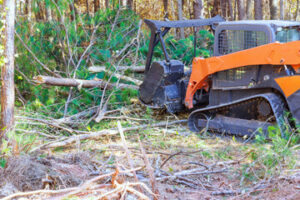Forestry Mulching Austin is an effective way to reduce the risk of wildfire and improve your property’s appearance. It also enhances soil health, prevents erosion and increases flora biodiversity.

Unlike traditional clearing methods that involve cutting and hauling away debris, forestry mulching turns trees, brush and vegetation into nutrient-rich mulch. Learn more about the benefits of this revolutionary land-clearing technique.
Forestry mulching is an effective way to protect wildlife habitats and prevent invasive species. In addition to minimizing the impact of clearing and preserving habitats, this method reduces soil erosion by retaining the organic matter that is otherwise washed away by rain or wind. It also supports native plant growth by promoting the ecological balance that wildlife depends on for food and shelter.
The use of forestry mulching equipment helps reduce the time, cost and environmental damage associated with traditional land clearing methods. It can be used to clean wooded acreages for residential properties, commercial developments and other purposes. It can even be incorporated into larger-scale forestry maintenance programs for timber harvesting and wildlife management.
By turning overgrowth into a protective layer that promotes the health of the soil, Forestry Mulching improves soil quality and prepares sites for future development projects. It can be applied to cedar, pine and other brushy plants that contribute to overgrowth and fire risk, as well as to crop stubble or invasive vegetation. The shredded material decomposes over time and enriches the soil with valuable nutrients. The mulch also moderates soil temperature, keeping it cooler in chilly seasons and warmer in summer heat to support healthy seed germination and root growth.
As with all projects involving the use of machinery, safety is paramount for those involved. Only trained and experienced professionals should be using forestry mulching machines to avoid injuries or property damage. The machines can be attached to skid steers, tractors or excavators and are used to clear vegetation around homes, offices, construction sites and other areas that require protection from overgrowth and invasive plants.
Unlike traditional land clearing methods that discard cleared debris, Forestry Mulching keeps the organic matter on-site and incorporates it into the ground, improving soil health and reducing costs. It also reduces the need for chemical fertilizers and herbicides. The process is especially beneficial for rural properties and natural environments because it encourages biodiversity and sustainable land management practices, including reducing wildfire risks, controlling invasive species and preparing soil for future planting.
Preserved Wildlife Habitats
Forestry mulching preserves wildlife habitats by selectively clearing overgrown vegetation while leaving a layer of organic mulch behind. This approach supports healthy plant growth and promotes a natural environment for animals to live in, while also enhancing soil health. Compared to traditional land-clearing methods like burning and hauling away unwanted debris, mulching is an environmentally friendly option that does not produce harmful greenhouse gas emissions or pollution.
Mulching also prevents wildlife habitats from being impacted by wildfires. Using the power of specialized machinery, forestry mulching transforms brush and other vegetative matter into a beneficial layer of organic material that deters fire hazards. This is especially important in areas prone to wildfires, where a proactive forestry mulching technique can drastically reduce the risk of fire damage and property loss.
In addition, forestry mulching is a great way to control wildlife pests and invasive species. Mulching machines effectively remove invasive underbrush and species such as buckthorn and multiflora rose, allowing grasses to grow and flourish for animal forage. In addition, the removal of invasive plants helps prevent the overcrowding and suffocation of trees, which can cause them to weaken or die from overcrowding and stress.
The use of forestry mulching is an effective and efficient method of controlling erosion on sloping land. The resulting layer of mulch creates a barrier that slows down water runoff, preserving the integrity of the soil and reducing the risk of flooding or flash floods.
In addition, the ability of forestry mulching to turn unwanted vegetation into a nutrient-rich mulch on-site eliminates the need for land clearing activities that require burning or hauling away waste materials. Burning releases carbon dioxide into the atmosphere and can contribute to climate change, while hauling waste requires additional vehicles and produces additional pollution and greenhouse gases. The ability of forestry mulching to effectively clear land while also promoting soil health and sustainability makes it an ideal choice for environmental conservation, agricultural production, land management, and land development projects.
Enhanced Appearance
Forestry Mulching is an efficient land clearing technique that reduces the time and costs of traditional methods. It is ideal for large and inaccessible areas that are difficult to clear with a tractor or other heavy machinery. The mulching process shreds trees, shrubs and brush to create an attractive layer of organic matter that prevents erosion and suppresses weed growth. The mulch layer also retains soil nutrients, eliminating the need for chemical fertilizers. This helps maintain ecological balance, improves soil health and prepares land for future planting or development projects.
The shredded vegetation that results from forestry mulching provides the perfect environment for native plants to grow. The layer of mulch prevents weeds from growing and suffocates the seeds of invasive species, promoting a more natural landscape. This process is particularly useful in restoring wildlife habitats, where the mulch provides food and shelter for local animals. It is also a critical tool for fire mitigation, as the layer of mulch slows the evaporation of moisture from the soil, decreasing the likelihood that wildfires will spread.
Aside from being an effective tool for fire prevention, forestry mulching is a game-changer in maintaining fence lines and power lines. Overgrown fence lines are an eyesore and can pose a safety risk, allowing animals to roam free on the property or damage power lines. Forestry mulchers can reach dense areas of undergrowth that are normally difficult to access on foot, providing a quick kill for invasive species.
Whether you have an overgrown residential property or are looking to clear land for commercial use, forestry mulching is the ideal solution. The specialized equipment used in this process transforms your vegetation into valuable resources that help to keep the land healthy and prepare it for future uses. The improved aesthetics and ecological benefits can also significantly increase your property’s value. Potential buyers and investors often prioritize properties that are well-maintained using eco-friendly practices, making forestry mulching an effective and cost-efficient way to enhance your property’s value.
Sustainable Land Management
Forestry mulching is an effective way to clear land without harming the environment. By turning invasive vegetation into natural mulch, the process helps to prevent soil erosion and improves the overall health of the land. Forestry mulching also helps to control weeds and promote future plant growth. This method of land clearing can be an effective way to help manage invasive species that threaten the biodiversity of native habitats and crops.
The forestry mulching process uses a machine to cut and grind up tree debris, then converts it into nutrient-rich mulch. This organic material can then be added to the soil and will slowly decompose over time, bringing back vital nutrients to the ground. This process also promotes soil health by preventing erosion, reducing the need for chemical fertilizers and allowing native plants to thrive.
Aside from its many environmental benefits, forestry mulching can improve your property’s appearance and add value to your home or business. The aesthetically pleasing look of well-maintained and clear landscapes can make your property more attractive to potential buyers or tenants. This eco-friendly and cost-effective clearing technique is an essential component of responsible land stewardship.
One of the main advantages of forestry mulching is that it preserves the root systems of the trees and shrubs being cleared. In contrast to traditional clearing methods that involve burning or uprooting, forestry mulching leaves the root system intact and reduces the risk of soil erosion. The mulch layer provides a barrier that protects the land from wind and water damage, helping to preserve soil health.
Forestry Mulching can also be used as an alternative to controlled burns, which are an effective way to remove green waste but have their own inherent risks. Pile burns can often spiral out of control, and they release smoke into the air, which can negatively impact local communities. However, forestry mulching eliminates the need for these techniques and provides an efficient, environmentally friendly solution for clearing lands.
The specialized equipment used for forestry mulching can handle a variety of different vegetation types, making it ideal for land clearing projects of all sizes. The forestry mulcher can accomplish the work of multiple pieces of heavy equipment, including excavators, shears and wood chippers, in a single machine. This saves on costs, time and labor, while protecting the integrity of the environment and ensuring consistent safety around fence lines, roads and power lines.


